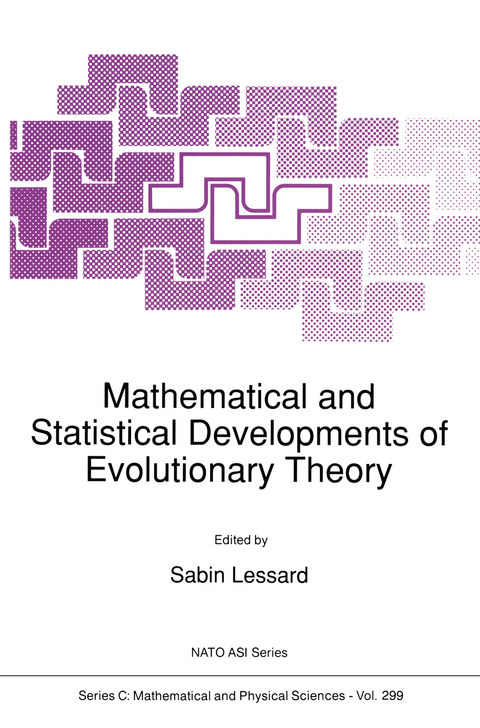
Mathematical and Statistical Developments of Evolutionary Theory
Seiten
2011
|
Softcover reprint of the original 1st ed. 1990
Springer (Verlag)
978-94-010-6717-1 (ISBN)
Springer (Verlag)
978-94-010-6717-1 (ISBN)
Mathematical and statistical approaches to evolutionary theory are numerous. Extensions of ESS theory to sexual populations and finite populations, not to mention games between relatives, are presented (W.G.S.
Mathematical and statistical approaches to evolutionary theory are numerous. The NATO Advanced Study Institute (ASI) held at the Universite de Montreal, Montreal, August 3-21, 1987, was an opportunity to review most of the classical approaches and to study the more recent developments. The participation of theoretical biologists and geneticists as well as applied mathematicians and statisticians made possible exchanges of ideas between students and scholars having different views on the subject. These Proceedings contain the lecture notes of seven (7) of the eleven (11) series of lectures that were given. ESS (Evolutionarily Stable Stragety) theory is considered from many perspectives, from a game-theoretic approach to understanding behavior and evolution (W.G.S. Hines), and a systematic classification of properties and patterns of ESS's (C. Cannings) to particular applications of the differential geometry of the Shahshahani metric (E. Akin). Extensions of ESS theory to sexual populations and finite populations, not to mention games between relatives, are presented (W.G.S. Hines). Special attention is given to the classical game called the War of Attrition but with n players and random rewards (C. Cannings). The Shahshahani metric is also used to show the occurrence of cycling in the two-locus, two-allele model (E. Akin). Various inference problems in population genetics are adressed. Procedures to detect and measure selection components and polymorphism (in particular, the Wahlund effect) at one or several loci from mother-offspring combinations in natural populations are discussed at length (F.B. Christiansen).
Mathematical and statistical approaches to evolutionary theory are numerous. The NATO Advanced Study Institute (ASI) held at the Universite de Montreal, Montreal, August 3-21, 1987, was an opportunity to review most of the classical approaches and to study the more recent developments. The participation of theoretical biologists and geneticists as well as applied mathematicians and statisticians made possible exchanges of ideas between students and scholars having different views on the subject. These Proceedings contain the lecture notes of seven (7) of the eleven (11) series of lectures that were given. ESS (Evolutionarily Stable Stragety) theory is considered from many perspectives, from a game-theoretic approach to understanding behavior and evolution (W.G.S. Hines), and a systematic classification of properties and patterns of ESS's (C. Cannings) to particular applications of the differential geometry of the Shahshahani metric (E. Akin). Extensions of ESS theory to sexual populations and finite populations, not to mention games between relatives, are presented (W.G.S. Hines). Special attention is given to the classical game called the War of Attrition but with n players and random rewards (C. Cannings). The Shahshahani metric is also used to show the occurrence of cycling in the two-locus, two-allele model (E. Akin). Various inference problems in population genetics are adressed. Procedures to detect and measure selection components and polymorphism (in particular, the Wahlund effect) at one or several loci from mother-offspring combinations in natural populations are discussed at length (F.B. Christiansen).
The Differential Geometry of Population Genetics and Evolutionary Games.- Topics in the Theory of Ess’s.- Selection in Natural Populations.- Population Genetics Theory - The Past and the Future.- A Discussion of Evolutionarily Stable Strategies.- Évolution Du Rapport Numérique Des Sexes Et Modèles Dynamiques connexes.- Topics in Evolutionary Ecology.
| Reihe/Serie | NATO Science Series C ; 299 |
|---|---|
| Zusatzinfo | 380 p. |
| Verlagsort | Dordrecht |
| Sprache | englisch |
| Maße | 155 x 235 mm |
| Themenwelt | Mathematik / Informatik ► Mathematik ► Angewandte Mathematik |
| Mathematik / Informatik ► Mathematik ► Statistik | |
| Studium ► 2. Studienabschnitt (Klinik) ► Humangenetik | |
| Naturwissenschaften ► Biologie ► Evolution | |
| Naturwissenschaften ► Biologie ► Genetik / Molekularbiologie | |
| ISBN-10 | 94-010-6717-1 / 9401067171 |
| ISBN-13 | 978-94-010-6717-1 / 9789401067171 |
| Zustand | Neuware |
| Informationen gemäß Produktsicherheitsverordnung (GPSR) | |
| Haben Sie eine Frage zum Produkt? |
Mehr entdecken
aus dem Bereich
aus dem Bereich
Eine sehr persönliche Geschichte | Der New York Times-Bestseller
Buch | Softcover (2023)
Ullstein Taschenbuch Verlag
CHF 30,75
Die revolutionäre Medizin von morgen (Lifespan)
Buch | Softcover (2020)
DuMont Buchverlag
CHF 22,40
Buch | Softcover (2022)
John Wiley & Sons Inc (Verlag)
CHF 169,95


